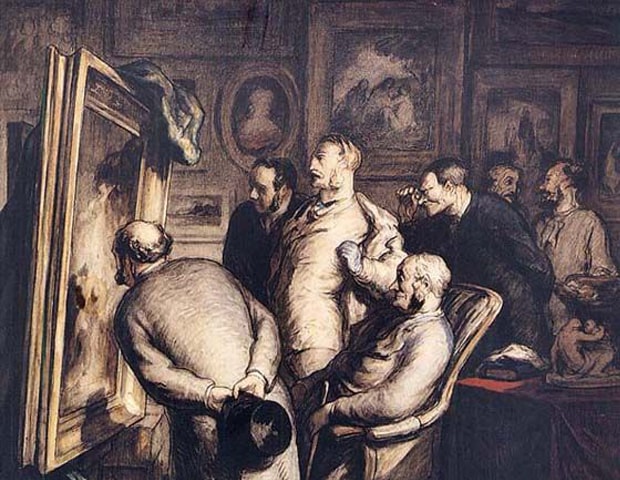
I recently had an unexpected but very enlightening conversation with two women on art. These women are highly accomplished individuals, well-travelled, well-versed in literature and history, with decades of pedagogical experience. On discovering that I am connected to the small and mythical percentage of the populace that identifies itself as artists or have something to do with them, they got visibly excited and asked me what they should keep in mind while viewing art. One of them recounted being at a museum in London during the summer, facing a large and beautiful painting but wondering whether it was a good painting or a bad one.
“How can I tell if the art I’m seeing is good or bad?” she asked me, much to my alarm, for we who presume to write about art hardly know anymore how to respond to straightforward questions. It is sad but it does reflect how much the art world has come to rely on ambiguity and prevarication. Directness is frightening.
I wove a complicated answer with references to technical mastery, art history, concept, context and market forces, but finally arrived at what I am sure would have been an infuriating statement that “there is no good or bad art.” Not satisfied with the effect this produced, I added a clumsier sentence: “If you like it, the artist must have done something right.”
Whether or not I was able to help my small, eager audience, I cannot say. But the conversation got me thinking about art and taste, and the role art criticism plays in distinguishing good art from bad art.
Does art criticism illuminate viewers or does it only serve as a self-indulgent literary genre?
It is no secret that artists themselves have largely distrusted and disliked art critics. Some have found writing and criticism on art, which they believe to be a complete and universal language in itself, to be redundant. For example, American abstract expressionist Barnett Newman resented how, for the sake of art criticism, “the art of painting is reduced from a fine art to an interpretive one, the artist’s role from that of a creator to one of a performer.”
Newman’s resentment is not wholly groundless. Art criticism, in step with developments in modern art, became a self-indulgent sort of literary genre that came to rely heavily on the reticence and enigma of the artist and the growing abstraction or indirectness of the art being produced. In the absence of a visible narrative or arrangement of easily readable signs, a work of art inspired and invited verbal meanderings.
This was a shift in the direction and function of art criticism, which had involved, in the 19th century, fierce denunciations or defences of artists, with the likes of John Ruskin championing J.M.W. Turner while scorning James McNeill Whistler and Charles Baudelaire promoting Eugène Delacroix while mocking Delacroix’s rival, Jean-Auguste-Dominique Ingres.
Many of these early critics served as buffers between newness of expression and public ire. They introduced pioneering ideas and artworks to the public and initiated a slow but crucial process of stretching the boundaries of art. The late 19th-century, painter and critic Roger Fry, for instance, brought around an (at first) offended English public to the genius of the post-impressionists. He can be credited, in part, for the esteem that artists such as Paul Gauguin and Paul Cézanne, continue to be held in the English-speaking world.
Although the 20th century produced its share of unsparing art critics such as Clement Greenberg and Brian Sewell too, some of the more important art criticism of the time was institutional critique that knocked down obsolete and damaging approaches to understanding and discussing art, such as Linda Nochlin’s 1971 essay ‘Why have there been no great women artists?’
The move away from pure art criticism to art writing that dealt with theory and philosophy was concurrent with the growing power in the art world of intermediary forces other than critics, namely art dealers and curators, who now are more likely to make and break reputations and launch and terminate trends. Of course, it can be argued that critics themselves relinquished a large portion of their power by becoming more guarded in their criticisms over time — more ingratiating and less honest.
Art critics and journalists such as Sarah Kent and Marc Spiegler have questioned, in some of their recent columns and writings, contemporary art writers’ pervasive desire to please. In a 2014 article in The Guardian, Kent stresses the need for criticism because, as she puts it, “adulation is as poisonous as neglect.” “We are encouraged,” she argues, “to regard ourselves as consumers who absorb rather than agents who think, assess or do. Good criticism exemplifies active engagement rather than passive consumption, and is an education for us all.”
This holds true for the local art sphere as well. Young art writers, especially, avoid being critical, and they are not entirely to blame. Power is concentrated among just a few factions of the local art world — factions that have not, unfortunately, developed a tolerance for criticism, so that none is acknowledged, let alone shared or discussed. One may hear all kinds of judgement passed on shows or artists’ works at private gatherings but none will usually appear in a published review. One feels, in turn, like one is part of a sitcom where everyone is unnaturally pleased with each other all the time.
What it all boils down to is this: art criticism is subjective, as is the viewing and reading of art. Art criticism can be prescient and historic or myopic and ill-founded but it should, at all costs, be lucid and accessible, and encourage viewers and readers to think, argue and reposition themselves every now and then.
Published in Dawn, EOS, November 4th, 2018















































Dear visitor, the comments section is undergoing an overhaul and will return soon.